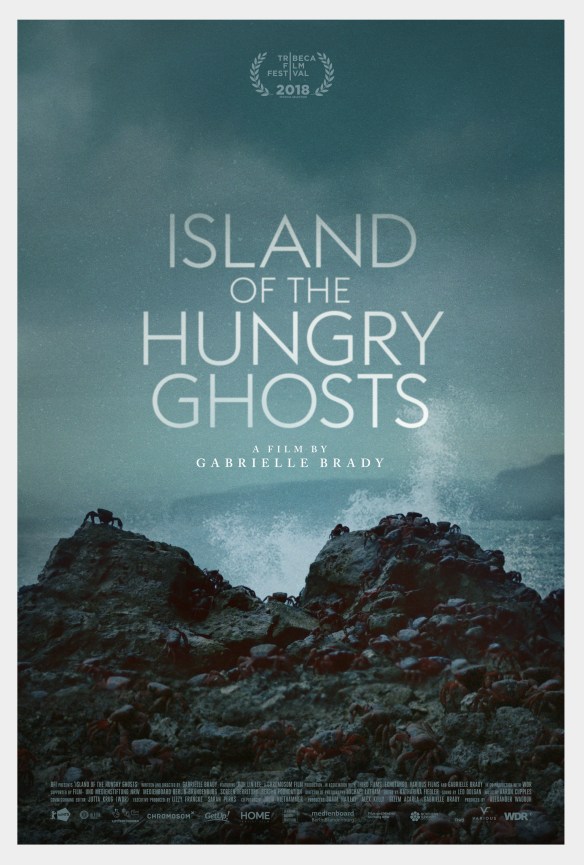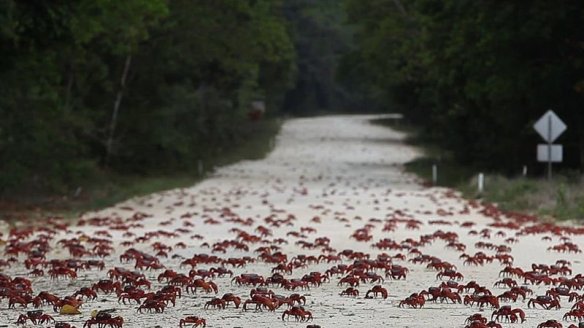Island of the Hungry Ghosts
Director: Gabrielle Brady
Writer: Gabrielle Brady
“Cast”: Arthur Floret, Poh Lin Lee
Part of: Viennale
Seen on: 4.11.2018
1-gif-review
“Plot”:
Poh Lin Lee is a trauma therapist working with asylum seekers on Christmas Island, part of Australia. They are held in a detention center at the heart of the island that seeems otherwise like an idyllic tourist spot, especially in the season of crab migration that is quite a spectacle. Poh Lin has her work cut out for her with the desperate people she is supposed to councel without being able to offer much in the way of hope. As the crabs migrate and the Chinese islanders perform their yearly ritual for the hungry ghosts – people who died on the island without a proper burial – Poh Lin has to figure out how she can deal with everything.
That Island of Hungry Ghosts wouldn’t be exactly easy watching was clear from the get-go but I nevertheless didn’t expect it to hit me quite as hard as it did. Feeling more like a feature film than a documentary, Brady gets to the truth of the matter, and it really isn’t a pretty one. But it is a great film, even if it left me wanting a drink.

As I myself am working to become a therapist (at some point), choosing Poh Lin as the point of view character for the story was especially interesting to me, but it’s also a very well chosen one for anybody who isn’t interested in the work itself as she gives us access to the asylum seekers and their stories as well as the island at large. Still, what struck me in particular was her struggle to stay empathic while not getting eaten by her work, as well as helping those asylum seekers without unduly supporting an unacceptable system. Her fight was obvious as well as doomed to fail.
And there is no doubt that the detention center and how people are treated there is unacceptable and cruel. The people are not seen as humans at all, they are nuisances and as a therapist, Poh Lin can only carve out a small space of reprieve for them. But whether that really makes things better? Sometimes I doubt it. (But of course it does.)

This inhumane treatment of the refugees is contrasted with the two other elements of the film: One is the crab migration where millions of crabs move from the jungle to the ocean. Their migration is seen not only as necessary and natural, but as a spectacle and people don’t hesitate to put in a lot of effort to protect them while they are on their move. The second element is the ritual for the hungry ghosts. They are seen to be trapped in limbo, the worst place anyone can be. The ghosts have left their old life behind, but because they didn’t get a proper burial, they can’t move on to the afterlife. Here, too, a lot of effort is expended to free them from that state because people know how horrible it is to be trapped in-between. And yet, the same consideration is not extended to the refugees trapped in the detention center where they can do nothing but wait (not that it’s the Chinese islanders who are remiss regarding the migrants. Both elements aren’t exactly a subtle comparison, but sometimes life is that obvious – and it’s effective.
Given how comprehensively the film shows how fucked up we deal with refugees (world-wide – this is not a phenomenon limited to Australia), it’s no surprise that it hurt watching it. But it’s necessary to tell this story and to spread it. And Brady does a great job there.

Summarizing: Required viewing.